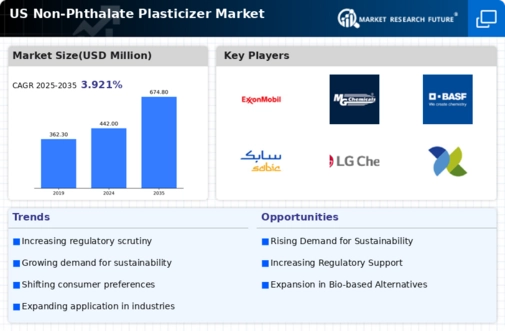The US Non-Phthalate Plasticizer Market has been experiencing significant growth, driven by increasing consumer awareness of health and environmental concerns related to traditional phthalate plasticizers. This market encapsulates a variety of non-toxic alternatives that cater to diverse applications, such as automotive, construction, and personal care products.
The competitive landscape is characterized by innovation, with players constantly seeking to improve formulations and expand their product offerings to meet specific industry needs. The landscape is further influenced by regulatory dynamics, as many manufacturers face pressure to comply with stringent safety regulations.
This has led to a surge in research and development initiatives aimed at creating bio-based and sustainable plasticizers that offer comparable performance to traditional options while ensuring safety for consumers and the environment. Mitsubishi Chemical Corporation has established a solid footing in the US Non-Phthalate Plasticizer Market, positioning itself as a key player through its commitment to sustainability and innovation.
The company has focused on enhancing its product portfolio by developing advanced formulations that comply with regulatory standards and appeal to a health-conscious market. Recognized for its strong research capabilities, Mitsubishi Chemical Corporation invests in extensive R&D to drive the development of safe, effective, and eco-friendly plasticizers.
The strength of the company's presence in the US market is further amplified by strategic partnerships, enabling it to distribute a wide range of products tailored to the specific requirements of various industries while maintaining a reputation for quality and reliability. Vasmedia is another prominent player in the US Non-Phthalate Plasticizer Market, known for its innovative approach to developing eco-friendly plasticizers that cater to the growing demand for sustainable solutions.
The company offers a range of key products, including non-phthalate alternatives that are suitable for various applications. Vasmedia focuses on research and collaboration to enhance its manufacturing processes and improve product performance. The company's strengths lie in its ability to adapt to changing market trends and its commitment to delivering high-quality, compliant products.
Additionally, Vasmedia has engaged in several strategic mergers and acquisitions to expand its market reach and integrate cutting-edge technologies, allowing for improved efficiencies and enhanced customer offerings in the US landscape. Through these efforts, Vasmedia has successfully solidified its position in the market while addressing the evolving demands of consumers and industries alike.



















Leave a Comment